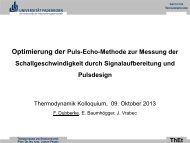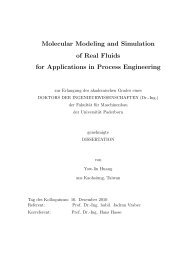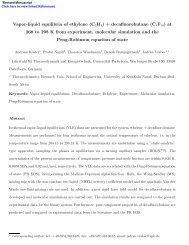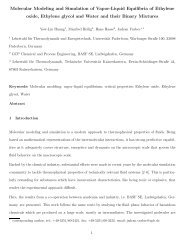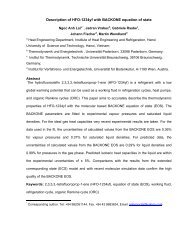ms2: A Molecular Simulation Tool for Thermodynamic Properties
ms2: A Molecular Simulation Tool for Thermodynamic Properties
ms2: A Molecular Simulation Tool for Thermodynamic Properties
You also want an ePaper? Increase the reach of your titles
YUMPU automatically turns print PDFs into web optimized ePapers that Google loves.
3.3.3. Chemical potential<br />
The chemical potential of a given component can be separated into the temperature dependent part µ id<br />
i (T)<br />
of the ideal gas contribution to the chemical potential of the pure component and the remaining contribution<br />
<br />
id<br />
µi T,x,p −µ i (T). The solely temperature dependent ideal gas contribution cancels out in the calculation of<br />
phase equilibria and is there<strong>for</strong>e not implemented in<strong>ms2</strong>. The chemical potential depends on the real substance<br />
behavior due to the molecular interactions and can be determined with <strong>ms2</strong> using two different techniques:<br />
Widom’s test molecule method and gradual insertion.<br />
Widom. A conceptually straight<strong>for</strong>ward approach to calculate the chemical potential of a componenti was pre-<br />
sented by Widom [31]. It allows <strong>for</strong> a determination of the chemical potential with low computational cost, both<br />
<strong>for</strong> pure substances and mixtures. For a three-center LJ fluid, the computational demand is shown in Table 1.<br />
The execution time <strong>for</strong> the determination of the chemical potential increases roughly linearly with the specified<br />
number of test molecules that are sampled.<br />
The accuracy of the calculation varies with the number of test molecules and the density of the investigated fluid.<br />
For very dense fluids, the results are subject to poor statistics and the method may even fail. Within limits, lower<br />
statistical uncertainties of the chemical potential can be achieved by inserting a large number of test molecules<br />
into the simulation volume.<br />
Gradual insertion. A more advanced method to determine the chemical potential, which is reliable also at very<br />
high densities, is gradual insertion. It is briefly described here, further details including all parameters are dis-<br />
cussed in literature [32, 33, 40, 41].<br />
Instead of inserting complete test molecules, a fluctuating molecule is introduced into the simulation, which can<br />
appear in different states of coupling with the other molecules. In the decoupled state, the fluctuating molecule<br />
does not interact at all with the other molecules, while in the fully coupled state, it acts like a real molecule of<br />
the specified componenti. Between these states, a set of partially coupled states has to be defined, each with a<br />
larger fraction of the real molecule interaction, cf. Figure 1.<br />
TheN-1 real molecules plus the fluctuating moleculeπl in the statel<strong>for</strong>m a set of sub-ensembles, which can be<br />
depicted by the following scheme<br />
[N +π0] ↔ [N +π1] ↔ ... ↔ [N +πl] ↔ ... ↔ [N +πk−1] ↔ [N +πk] . (2)<br />
To switch between neighboring sub-ensembles, an additional move is introduced in a standard MC simulation.<br />
The probability of accepting a change of the fluctuating molecule from a state of couplingl to a state of coupling<br />
m is given by<br />
Pacc(l → m) = min 1, ωm<br />
ωl<br />
exp − ψm −ψl <br />
, (3)<br />
kBT<br />
where ψl denotes the interaction energy of the fluctuating molecule in the state l with all other N − 1 real<br />
molecules andkBT is the Boltzmann constant multiplied by the temperature. The states of coupling are weighted<br />
by the weighting factors ωl to avoid an unbalanced sampling of the different states. If specified, the weighting<br />
9



